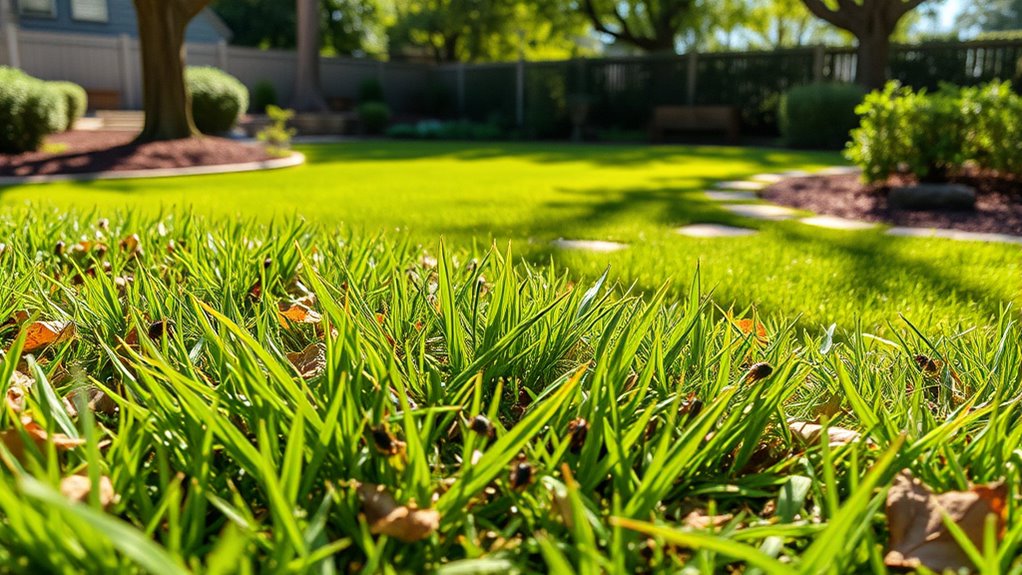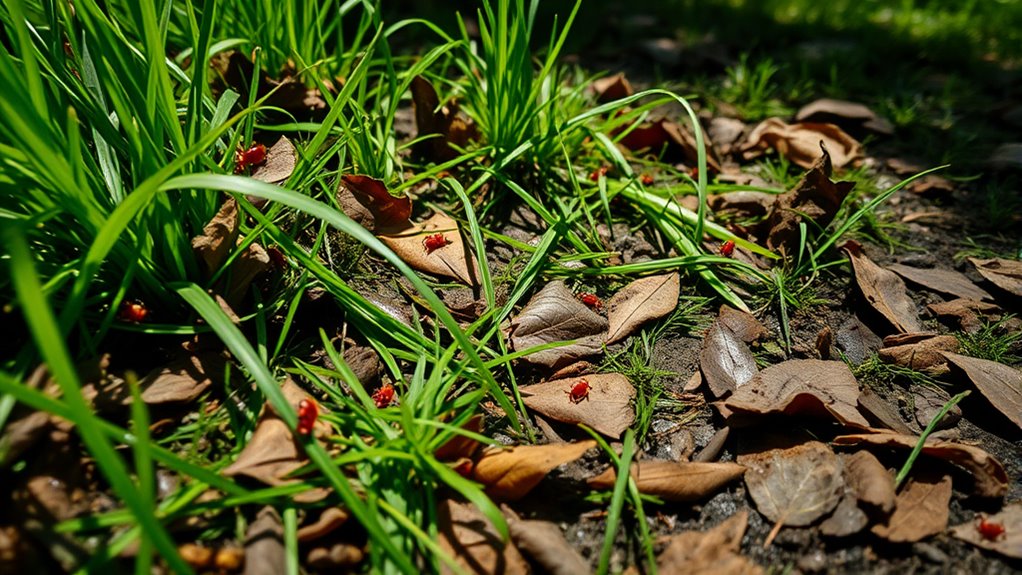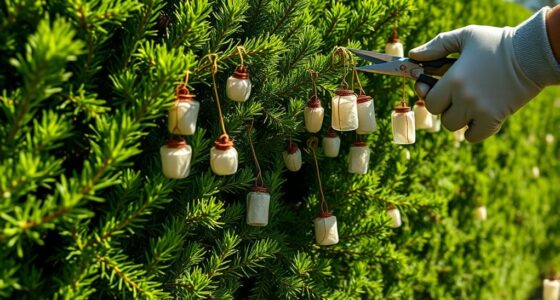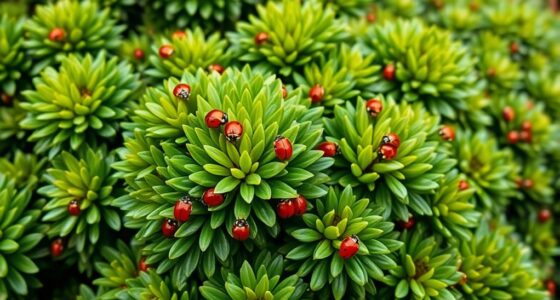To reduce ticks in your yard, focus on removing their favorite habitats and discouraging wildlife hosts. Clear leaf litter, brush piles, and tall grass, and trim shrubs regularly to minimize shaded, damp areas where ticks thrive. Install barriers around gardens to keep out wildlife like deer and mice, and limit attractants such as bird feeders and fallen fruit. These strategies will help create a less inviting environment for ticks—more tips await if you continue exploring.
Key Takeaways
- Remove leaf litter, brush piles, and tall grasses to eliminate moist, sheltered tick habitats.
- Trim and space native plants to prevent dense thickets that harbor ticks and wildlife hosts.
- Use fencing or barriers around gardens to deter wildlife that can carry ticks into yards.
- Regularly mow grass and manage dense vegetation to reduce shaded, damp areas ideal for ticks.
- Limit wildlife attractants like fallen fruit and scattered birdseed to decrease host presence near your yard.

As the weather warms up, ticks become more active in your yard, posing a risk to both your family and pets. To keep these pests at bay, understanding their habitat is vital. Ticks thrive in environments that provide them with the moisture and cover they need, often making your yard a perfect breeding ground if you’re not careful. One key strategy is reducing habitat features that attract wildlife, which are primary hosts for ticks. Wildlife attractants like bird feeders, brush piles, and unmanaged leaf litter draw deer, rodents, and other animals that carry ticks. These animals not only bring ticks into your yard but also sustain their populations, making it more challenging to control infestations.
Incorporating native plants into your landscape is a smart move, but you should do so thoughtfully. While native plants are beneficial for supporting local ecosystems, some can inadvertently serve as wildlife attractants if they create dense, shaded areas or provide cover for rodents and birds. To minimize this, select native plants that don’t grow excessively tall or dense, and space them appropriately to prevent creating thick thickets. Regularly trimming and maintaining your native plants can reduce shaded spots and damp areas where ticks and their hosts like to hide. Avoid planting large clusters of dense shrubs or creating overly shaded zones, as these can become hotspots for wildlife activity.
Removing or managing features that attract wildlife is equally important. Clear away leaf litter, brush piles, and tall grasses, especially near your home and play areas. These spots offer ticks a moist, protected environment, and wildlife like mice and deer often venture there. Limiting food sources for wildlife, such as fallen fruit or birdseed scattered on the ground, can also help reduce their presence. If you feed birds, do so at a designated, tidy area away from main play zones, and clean up spilled seed regularly. Using fencing or barriers around vegetable gardens and flower beds can discourage larger animals from entering your yard and bringing ticks with them. Additionally, understanding the role of contrast ratio in visuals can help when creating effective signage or barriers to keep wildlife out.
Frequently Asked Questions
How Do Ticks Find Their Hosts in the Yard?
Ticks find their hosts through their keen host detection behavior, sensing body heat, carbon dioxide, and vibrations. As you move through your yard, ticks latch onto grass, shrubs, or leaf litter, waiting for a host to pass by. When you come close, they crawl onto your skin or clothing. To reduce this, you can clear tall grass, trim bushes, and remove leaf litter, making your yard less attractive to ticks.
Are Certain Plants More Attractive to Ticks?
You might think plants are harmless, but some native plants and ornamental shrubs are like irresistible tick magnets. These plants create the perfect hiding spots, making it easier for ticks to latch onto hosts. Dense native flora and lush ornamental shrubs provide ideal habitats, increasing your risk of tick encounters. To reduce this danger, consider trimming or removing these plants, and create open, less inviting areas in your yard.
Can Removing Leaf Litter Eliminate Tick Habitats Entirely?
Removing leaf litter alone won’t eliminate tick habitats entirely, but it markedly reduces their numbers. By practicing habitat modification through leaf litter removal, you remove the moist, shaded areas where ticks thrive. Regularly clearing leaf litter and debris makes your yard less inviting for ticks, decreasing your risk of bites. Remember, combining leaf litter removal with other measures like tall grass trimming and creating dry, sunny zones offers the best protection against ticks.
How Often Should I Treat My Yard for Ticks?
You should treat your yard for ticks every few weeks during peak tick season, typically spring and summer. Use outdoor tick control methods and consider planting tick repellent plants like lavender or garlic around your yard. Regularly mowing grass, removing leaf litter, and creating barriers can also help. Reapplying treatments as needed guarantees ongoing protection, especially if you notice increased tick activity or after heavy rains that can wash away barriers.
Do Ticks Prefer Shaded or Sunny Areas in the Yard?
Ticks prefer shaded areas in your yard because their habitat preferences include moist, cool environments that help them survive. Tick behavior shows they’re more active and likely to latch onto hosts in shady, humid spots like under bushes, tall grass, and leaf litter. To reduce tick presence, you should focus on reducing shaded hiding spots, trimming overgrown vegetation, and keeping your yard dry and well-maintained.
Conclusion
By reducing your yard’s clutter and brush, you’re planting seeds of safety—a shield against ticks that linger like shadows in overgrown spaces. Think of your yard as a garden of protection, where each cleared corner is a sunbeam pushing back the darkness. When you take these simple steps, you’re not just removing ticks; you’re sowing a future of peace and peace of mind, turning your outdoor haven into a fortress of health.









